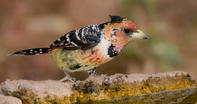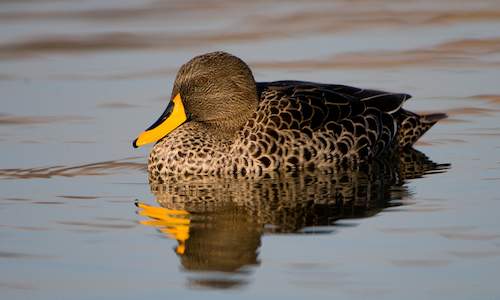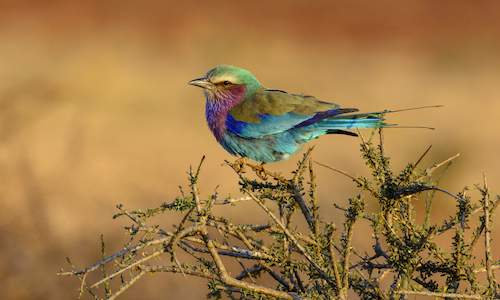
Name
Crested barbet (Trachyphonus vaillantii)Appearance
The crested barbet has a speckled yellow and red face with a small black crest. The belly is yellow with red speckles, the wings are black with white specks and it has a broad black band on its neck. It has a thick bill and the colourful plumage blends well in the bush. They have a distinct call.Crested Barbet Diet
The crested barbet feeds on insects, other bird’s eggs and fruits.Crested Barbet Breeding
The crested barbet is monogamous and territorial during breeding. Territory size varies according to their habitat. The nest is a hole in a tree or a nesting log placed in a garden. The female lay 1 to 5 eggs in September to December in South Africa.Incubation lasts between 13-17 days and is mostly done by the female. The young hatch naked and blind and fledge after about 31 days. They are fed insects by both parents. Faecal material is removed regularly. Up to five broods have been recorded in a breeding season.
Crested Barbet Behaviour
The crested barbet is found singly or in pairs. They hop around on the ground looking for food as they do not fly easily and then only short distances. It is a very vocal bird with the call being a trill that can continue for long periods.Crested barbets are territorial and aggressive towards other birds. They chase off nest competitors such as other barbets and also any other birds such as doves and thrushes. They have also been recorded to have attacked rats and killed snakes.
 When a bird wishes to vocalize, it contracts its lungs sending a jet of air through the syrinx and by vibrating the fleshy membranes it cont...
When a bird wishes to vocalize, it contracts its lungs sending a jet of air through the syrinx and by vibrating the fleshy membranes it cont... SouthAfrica.co.za provides informative, educational content on many South African bird species that orthologists and bird-watchers would enj...
SouthAfrica.co.za provides informative, educational content on many South African bird species that orthologists and bird-watchers would enj...